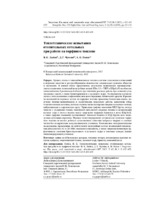| dc.contributor.author | Любов, В. К. | |
| dc.contributor.author | Чухчин, Д. Г. | |
| dc.contributor.author | Попов, А. Н. | |
| dc.coverage.spatial | Минск | ru |
| dc.date.accessioned | 2022-11-11T11:57:01Z | |
| dc.date.available | 2022-11-11T11:57:01Z | |
| dc.date.issued | 2022 | |
| dc.identifier.citation | Любов, В. К. Теплотехнические испытания отопительных котельных при работе на торфяном топливе = Thermal Engineering Tests of Heating Boiler Houses when Working on Peat Fuel / В. К. Любов, Д. Г. Чухчин, А. Н. Попов // Известия высших учебных заведений и энергетических объединений СНГ. Энергетика. – 2022. – № 5. – С. 422-435. | ru |
| dc.identifier.uri | https://rep.bntu.by/handle/data/122366 | |
| dc.description.abstract | Процесс отказа от невозобновляемых топлив в системе сложившихся отношений к вопросам экологии и ресурсосбережения повсеместно сопровождает развитие общества и экономики. В данной статье представлены результаты комплексных промышленно-эксплуатационных испытаний водогрейных котлов КВм-2,0 с ТШП и КВр-0,4К на объектах теплоснабжения Архангельской области при типичных режимах работы при сжигании угля, топливных смесей, а также брикетированного и кускового торфа. Эксперименты осуществлялись с использованием современных методов и передовых технических средств. В рамках исследований по переводу котлов на торфяное топливо проведены балансовые опыты, получены технико-экономические и экологические показатели работы, выполнены отбор и анализ очаговых остатков, детально изучены мелкодисперсные твердые и сажевые частицы, выбрасываемые в окружающую среду. Приведены графики изменения КПД брутто, потерь теплоты с уходящими газами, химической неполнотой сгорания топлива и концентраций оксидов серы и азота в период между загрузками торфяных брикетов в котел КВр-0,4К, а также графики изменения составляющих теплового баланса и КПД брутто всех исследуемых котельных агрегатов. Перевод теплогенерирующих установок на сжигание торфяного топлива позволяет добиться существенного снижения выбросов твердых и сажевых частиц без модернизации золоулавливающих установок. Комплексные экспериментальные исследования, проведенные на действующих водогрейных котлах номинальной теплопроизводительностью 0,4 и 2,0 МВт, показали возможность, а также энергоэкологическую эффективность сжигания брикетированного и кускового торфа в топочных камерах данных теплогенерирующих установок. | ru |
| dc.language.iso | ru | ru |
| dc.publisher | БНТУ | ru |
| dc.title | Теплотехнические испытания отопительных котельных при работе на торфяном топливе | ru |
| dc.title.alternative | Thermal Engineering Tests of Heating Boiler Houses when Working on Peat Fuel | ru |
| dc.type | Article | ru |
| dc.identifier.doi | 10.21122/1029-7448-2022-65-5-422-435 | |
| local.description.annotation | Modern development of society and the economy is generally accompanied by abandonment of non-renewable fuels in the system of existing attitudes toward environmental issues and resource conservation. The paper presents the results of complex operational tests of КВм-2.0 water boilers with automatic stoker and КВр-0.4K at heat supply facilities of the Arkhangelsk region under the typical operating conditions on coal, fuel mixtures, and also peat briquettes and sod peat. Experimental work was carried out using modern methods and advanced technical means. Within the framework of the research on the conversion of boilers to peat fuel, balance experiments were carried out; technical, economic and environmental performance indicators were obtained; the selection and analysis of focal residues were carried out, fine solid and soot particles polluted into the environment were studied in detail. The paper presents graphs of changes in gross efficiency, heat loss with exhaust gas, heat loss with incomplete combustion, and concentrations of sulfur and nitrogen oxides during the cycle between loading peat briquettes into the КВр-0.4K boiler, as well as graphs of changes in the heat balance components and gross efficiency all boiler units under investigation. The conversion of heat generating plants to peat fuel combustion makes it possible to achieve a significant reduction in emissions of solid and soot particles without upgrading ash-collecting plants. Complex experimental studies conducted of existing hot water boilers with a nominal heating capacity of 0.4 and 2.0 MW have shown the possibility, as well as the energy-environmental efficiency of burning briquetted and sod peat in the combustion chambers of these heat generating plants. | ru |

